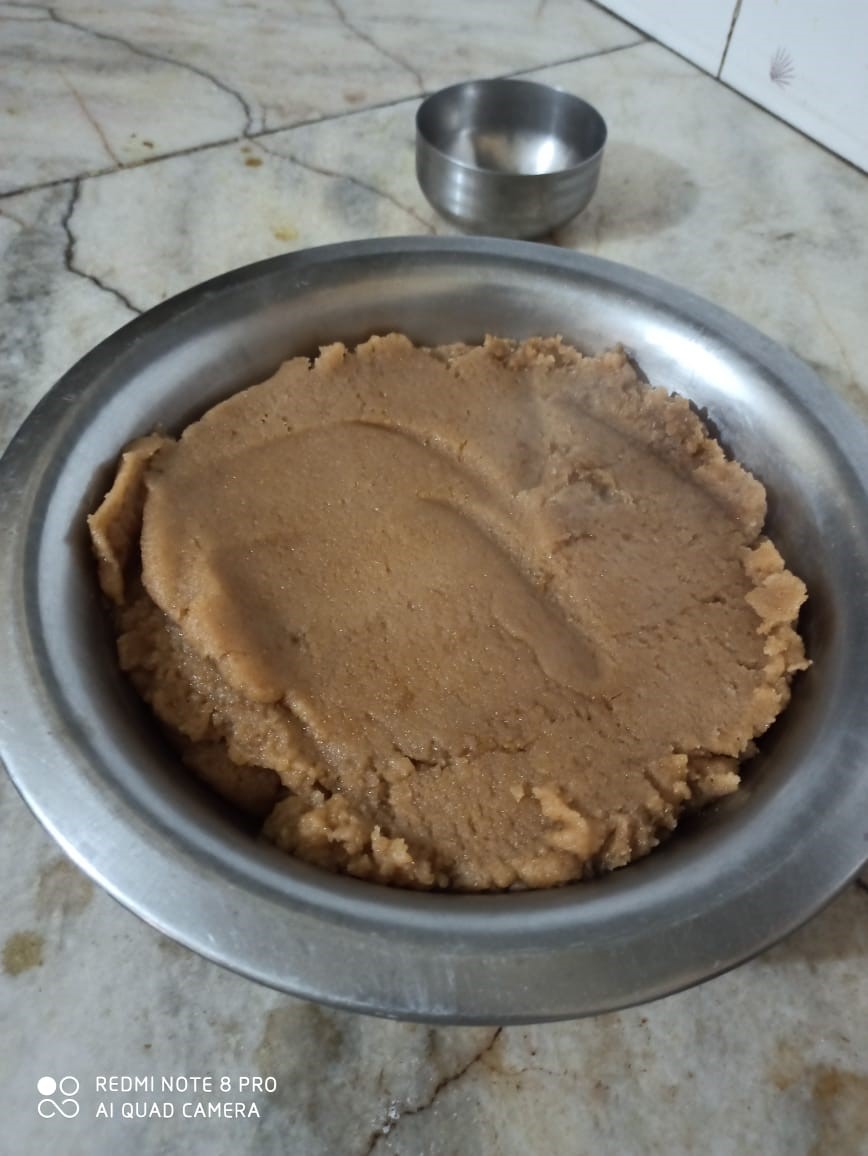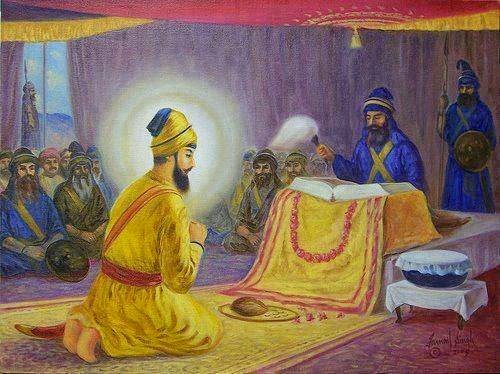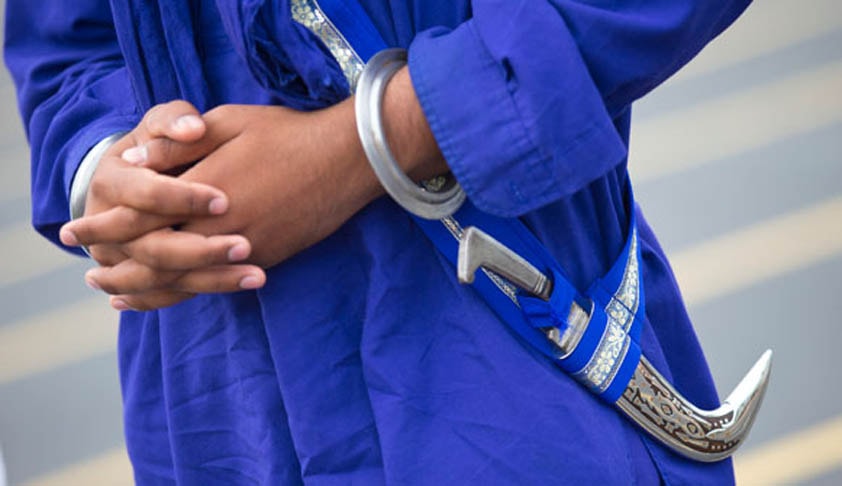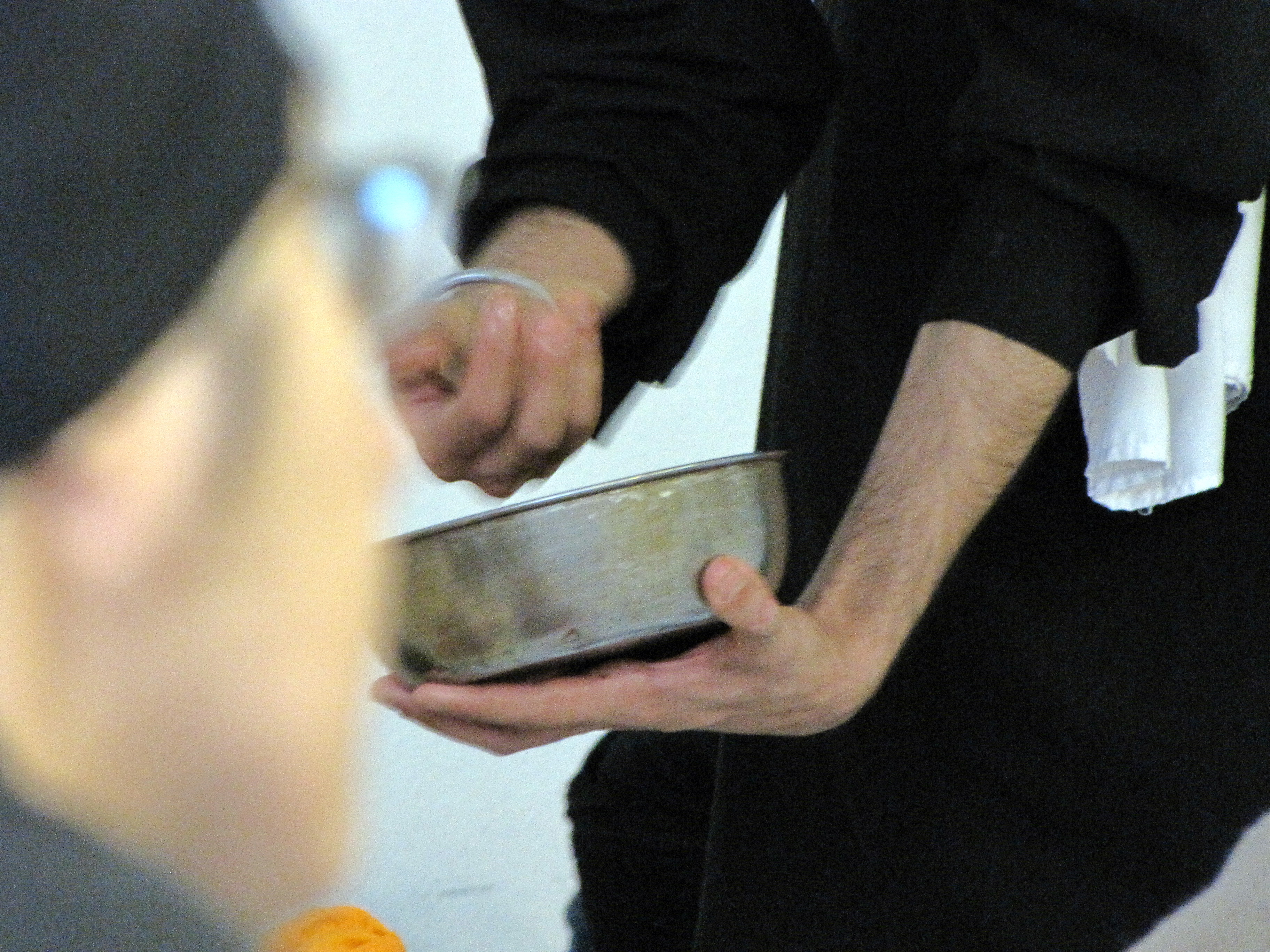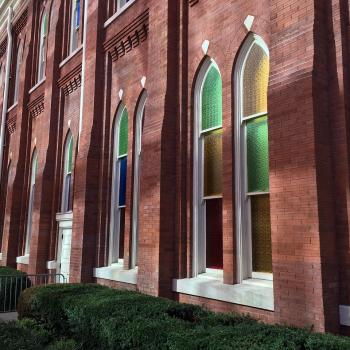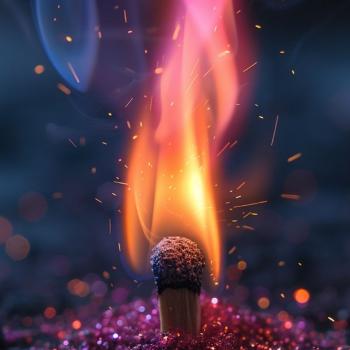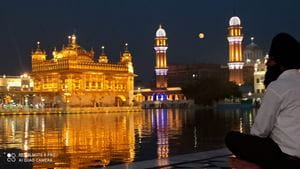
"Religion Behind the Scenes" spotlights the less visible, but no less crucial, tasks that keep religious communities running, and the people who make it all happen.
For the 25 million Sikhs spread throughout the world, partaking of karah prashad—as a kind of offering and a blessing—is commonplace, though holy. Whether at the flagship temple, the Golden Temple (in North West India), or at one of the local gurdwaras, the daily worship engaged in by faithful practitioners includes the offering of and partaking of karah prashad.
Mr. Bilumber Singh, the head priest at the famed Gurdwara Saragarhi (in Firozpur, India), has been making prashad since he was only twelve or thirteen years old—more than thirty years; and while his current responsibilities at the gurdwara no longer make it possible for him to continue to make the prashad, in this interview he will share a bit about this sacred food, what it means to practitioners of the faith, and what it has meant to him personally to participate in the making and offering of karha prashad to the Guru Granth Sahib.
If you were talking to someone who is not a Sikh, and you were trying to briefly explain to them what prashad is, how would you explain it?
Karah prashad is an offering made at a temple or gurdwara. It is offered to the Guru Granth Sahib, and then distributed to the worshipers in attendance. I once heard someone refer to it as God’s “leftovers” and, for us, it is very special. It is a special blessing of the Guru. Like, when I go to the temple, if I don’t get prashad, I feel like something is incomplete. You know? Because I feel that it was specially made, with the prayers and, you know, a special ritual; so that way the karah prashad is always very special because it is something that the Guru has partaken of.
Of course, in the other local gurdwaras, people can bring sweet meats, you know, other sweet things. But, in the inner sanctum of the Golden Temple [in Amritsar, India], you cannot offer anything else except the degh which is made in the Golden Temple itself. So, for me it is very special.
What are the ingredients in karah prashad?
Well, that’s a very interesting question. So, there is wheat flour and sugar, and there is also ghee (or clarified butter) and water. I can tell you also that the unique feature is that the ingredients are supposed to be in equal proportion to each other. The three main ingredients (of flower, sugar, and ghee) are added in exactly the same proportion, and the water is added at three times the proportion. So, it is three parts water, one part flower, one part sugar, and one part ghee (or concentrated butter).
Are the priests the only ones allowed to make the prashad? And, if so, are the Sevadaars (or “servicers”) priests?
Actually, in big gurdwaras—like the Golden Temple, or in other historically significant gurdwaras—the general rule is that there is one person, who is officially an employee, that has been through the Amrit ceremony, meaning they are basically “baptized” and are a member of the Sikh Khalsa. They make the karah prashad.
“Khalsa” means “pure”—and the members of this group were originally part of the Sikh military. Today, you might say they are “pure” ones who are part of the Sikh “brotherhood”; very faithful ones, engaged ones. They are Sikhs who faithfully participate in nitnem banis, or the five daily prayers of Sikhism. These are prayers that a Khalsa has to do every day. So, a person who observes all of those norms, is a Khalsa, does the daily prayers—I mean, he is following everything as per the rules; only that person (who is an employee of the gurdwara) makes the khara prashad or what you might call the “sacred food.”
So, in the Golden Temple, there is generally only one person who will prepare the karah prashad. His job is that alone; he doesn’t do anything else, but he only prepares the karah prashad which is offered to the Guru Granth Sahib right inside the inner sanctum. This tradition is very strict in the major historical gurdwaras, like the Golden Temple but, in other gurdwaras (like neighborhood gurdwaras) it is a bit more lax—and that would certainly be the case with Sikh gurdwaras outside of India, like those in the United States.
So, do women ever make at the prashad at the gurdwaras, or is it only the men who do so?
There is no written rule, no hard and fast rule, but it is a general practice in historic gurdwaras that it is the male sevadaars, you know, who make the karah prashad. If a woman is employed by the gurdwara, she generally would be employed to make the langar instead. (The langar, of course, is the meal that we share free of any cost, which shows by our eating together that we make no distinction between caste, gender, race, social status, or even religion. We must never discriminate, and the langar highlights that principle.) Men will also help cook and serve the langar—and clean up after it. But the general practice with karah prashad prepared in the gurdwara is that the men do that.
What inspired you to participate in the making of prashad at the Gurdwara? What got you into this work at such a young age—at 12 or 13-years old?
I was training to be a priest, so this was part of that work; something I had to learn how to do. I started making and helping to distribute prashad when I was in my teens—some thirty years ago. Of course, as the head priest at my gurdwara, I no longer make it (because I have other responsibilities); but I still supervise all of the work at the gurdwara, which includes the making and distribution of the prashad. On a day-to-day basis, we have what we call (in Hindi) sevadaars, who are what you might call “juniors”—you know? Their title means “servicer” or “one who serves,” and they make the prashad each day.
What is involved in preparing the karah prashad?
When you prepare it, there are certain rules to be observed. For example, the kitchen has to be completely cleaned first. And the person who is making the karah prashad generally recites one full part of the Japji Sahib—which is found at the beginning of the scriptures. (It was composed by Guru Nanak Dev Ji, the founder of Sikhism.) That one, full, long prayer of Japji is recited while preparing the karah prashad. The recitation takes around 10 to 15 minutes, I don’t think you could prepare the karah prashad in less than that amount of time.
So, the thing is that, in the neighborhood gurdwaras, it is not as strict. There, the idea is to create accessibility for the local devotees so that they feel more at home and they want to come there again and again. So, what they do is they will prepare the karah prashad during the morning prayers and the evening prayers, but the devotees also sometimes will prepare it at home and then take it to the gurdwara and offer it there. And, when they do so, they will follow the traditional preparation rituals, much like the priest would in the historic gurdwaras.
Now, we call the khara prashad “degh” because degh is anything which is going to be served as food—including khara prashad—which is first offered as food to the Guru Granth Sahib.
There is a special ritual which we call “akhand path.” “Akhand” means “without any break” or “continuous.” And “path” means what you call “recitation” or “reading” of the scriptures. The recitation of the entire Guru Granth Sahib takes approximately 48 hours—when you do it without stopping or pausing. So, that is a very special ritual that is carried out. You can do it when you have a special occasion in your home, when you want the blessing of the Guru Granth Sahib. And, every day, you offer degh to the Holy Scripture. So, degh is anything that is offered as food to the Guru Granth Sahib.
In preparing the karah prashad, here is a special ritual where a small dagger, called a “kirpan,” is used to cut the degh (or food offering) with it, and then that offering, or food, becomes pure. That is what we call “bhog”—meaning that the required observance has been completed or fulfilled and the Guru Granth Sahib has partaken of the offering.
How is the prashad offered to the Guru?
Well, after it is made, the prashad is covered with a clean cloth, and then it is placed on a platform in front of the Guru Granth Sahib. Then a portion of the Anand Sahib, which is a collection of Sikh hymns, is sung or recited in the presences of the Granth. Then a sevadaar removes the kirpan from its sheath and, standing, facing the Guru Granth Sahib, he holds the handle of the dagger between folded hands—and then touches the kirpan to the prashad, passing the blade through it.
In a symbolic representation of the five panj pyare, the five “beloved ones,” who were part of the formation of the original Khalsa, five portions of prashad are distributed to those present. After it has been offered to the Guru Granth Sahib, one portion is placed in a bowl for the person attending the Guru Granth, and then the other portions are distributed from a bowl to the congregation, as I noted, without any discrimination, no matter the religion, race, social position, or caste of those present.
Are there aspects of the job that might surprise people, or misconceptions about making Prashad, that might surprise people?
Yeah, so a very interesting thing. The constitution of the prashad is to be of wheat flour and sugar and pure clarified butter only. But there are people who will say, “Oh, I want to make it more fancy.” And they will add things like dry fruits into it, or they will add other things into it. But that is like going away from the norm, that is, because the Guru wanted it to be simple, so that everybody can make it. The ingredients are very simple things which are there in every Indian kitchen. So, the idea was to not accessorize it with very rich, dry foods, or something like that. Keep it simple, nutritious, and pure. You cannot add any synthetic butter to it. You have to have only pure, clarified butter in it. You cannot add anything synthetic, or any other ingredient. It would be inappropriate to offer prashad to the Guru Granth Sahib which had other things in it, other than the traditional ingredients.
Guru Nanak Dev Ji met some yogis, you know, and they told him that they wanted to have something which they could eat. And they said to him, “Look, we are so old. We don’t have teeth. So, we want something that we can eat.” So, the Guru then said, “All right then, let this be the prashad for everybody.” Any old person can eat it. You don’t require teeth to eat it. A newborn baby can chew it. So, it is for everybody. That is the beauty of it. I’ve seen people making it at home, and they will garnish it with a lot of dried fruit, and all that. But the beauty of karah prashad is that it is so tasty, and yet so simple.
Has the process of how it is made changed much over the years, or has it largely remained same?
It’s the same! These norms have been set by the gurus. Guru Nanak Dev Ji introduced prashad. It is a very, a very strict norm. So, just as there can be no change in the Guru Granth Sahib, the scriptures—you cannot make any changes in any line, or word, of the Guru Granth Sahib; similarly, you cannot make any changes in the preparation of the karah prashad, or in the distribution of it. So, it has remained the same since the fifteenth century.
What is the most sacred side of this work to you?
I feel that I am doing something special, as a gesture to be taken to or offered to the Guru—and there’s a special feeling attached to that because, you know, the Guru is going to partake of it.
Karah prashad has generally served as the concluding part of worship. So, there is a final prayer—for which everyone stands up. The prayer says to the Guru Granth Sahib, in essence, “The karah prashad is there before you. Please partake of it and, with your blessing, let it be distributed among the devotees present. And whoever partakes of it, may they recite your name.” It is a blessing from the Guru upon the devotees who have come to worship.
Another point: if you see the composition of the karah prashad, which is very nutritious—with wheat flower, sugar, and clarified butter—all these give strength to the body. So, the idea is that, when you sit there and you listen to the musical recitation of the scriptures, that is nutrition for the soul, whereas karah prashad is nutrition for the body.
When the karah prashad is sitting before the Guru Granth Sahib and the recitation of the Granth’s words are being sung, the prashad becomes “special.” Just like the sugar, butter, flower and water all merge together and become “one,” where they cannot be separated; similarly, when you listen to the words of the Guru Granth Sahib, and you follow the path of life it lays out, the lessons that are there should also be imbibed in your mind as a complete whole. That is food for your soul.
Do you have any unusual story or experience as it relates to prashad?
I remember one. A friend of mine had an experience. Being a Sikh, she is used to receiving the karah prashad at the end of what you might call the “worship.” So, once when she saw this Hindu ritual of Garbhadan. I don’t know whether you know it; you know, when they burn the fire, and then they recite mantras. Well, she was there watching that, and there is no prashad as part of it. It is Hindu, not Sikh. So, the first time she sat for it and, at the end of it, she was waiting, really expectantly, for something like karah prashad. So, she looked around, and they said, “It’s over.” And she said, “What do you mean ‘It’s over!’?” It felt wrong to her, because there was no prashad at the end—no “blessing” from the Guru or God at the conclusion of the worship.
Is there anything else about karah prashad that a non-Sikh should know or understand?
Oh, many things. Remember, there’s a way in which you take the prashad. You have to, you know, join both your palms together, and then the prashad is put into your hands. In the Golden Temple, if you put one palm forward, they will say, “Join both hands.” They will ask you to join both hands. And, you know, the gesture of your palms up means you’re ready to receive. The idea is that if you join your hands together, God is only too happy to give to you, to fill them with blessings. So, the idea is not just opening your hands, but of opening your heart. So, when you get prashad, it is a blessing from the Guru; but you have to open your hands and be ready to receive it. It is supposed to be done that way because that shows your humility, that you are ready to receive it.
Also, when you take karah prashad, you are supposed to cover your head because you’re not taking a sweet, it’s a prashad—an offering made to God. I think the relationship with the Guru Granth Sahib is one of respect. So, the more respect you give, that shows your love; and the more blessings you receive. And, you know, the funny thing is, I think people who become so devoted to God finally end up asking for nothing else except God’s love. All their desires, everything, just goes away, and all that they seek is the love and blessings of the Lord; and that is the beauty of devotion. I think all of us, if we want to follow the path of devotion—consciously or unconsciously—must aspire to reach that stage where we don’t want to ask for anything else.
Oh, another thing I have to tell you. I do this, and I am sure many people do it. Whenever prashad is given to us, we see to it that none of it falls to the ground. And, if it falls down, we pick it up from the floor; we don’t let it be, because it should not be trampled on.
There is one thing which must be remembered, which is that when the prashad is distributed, you may be of high rank or wealth or whatever but, for sure, it is distributed the same to everybody. There’s nothing like, you know, people who are rich should get it first, or people who are less in rank will get it later. It is just distributed, starting from one row, and whoever is sitting there—rich, or poor, or whatever—will get it first.
Everybody should be on a spiritual journey because, in the Guru Granth Sahib, it says very clearly that the real purpose of human life is to connect with God. In the world, we may have any role, or any profession, or any work. That is something which we have to do to sustain ourselves in the world. But the real purpose of every human life actually is to merge with God. We say that human beings are supposed to be the best of the Lord’s creations, because they have a mind, they have a conscience, they have an understanding of ethics—what is right or wrong. Animals move by instinct. But human beings do things consciously. So, you have no excuse if you do wrong. Animals kill, but it is not for the taste of what they kill. That is their way of survival. But we kill, not for survival, but for gain. What I love about the Guru Granth Sahib is that it is a guide to life, how to live your life. And it talks about the devotee who really wants to follow God’s way is not going to find it easy in this world. There was one sermon which I was reading, and it says, in essence, “God’s way of life is very difficult, very difficult. And God’s way of life is very easy, very easy.” Difficult if you resist God’s way; easy when you accept it.
You know, these days, with all of this crisis happening, I’m just beginning to kind of surrender. I mean, I know a man who rose very fast in his career and worldly success. Then, quite suddenly—within three or four days of contracting COVID—he passed away. He died. The news was so shocking. And, you know what, this is the irony. He was probably thinking, “I will get through this.” But then he died. It just goes to show that things that we consider so important here often aren’t the things which are lasting. Suddenly, everything just stops, and you don’t even get a chance to say goodbye. This is what this whole crisis has taught us. We used to think that we are very powerful because we humans control nature, we can fly in the air, and do things like that, you know? And now, it seems like God has entered the world, and we are not able to control things like we thought we could. When God decides to do something, you’re not able to control even a small virus. It’s a lesson in humility; or it should be. Karah prashad reminds us that our blessings come from God; and we should prepare ourselves to receive those with both palms open and faced upward; heads bowed in humility.
Interview conducted, transcribed, edited, and condensed by Alonzo L. Gaskill. Translated by Dr. Pushpinder Walia.
ABOUT ALONZO L. GASKILL, PH.D.
Alonzo L. Gaskill is an author, editor, theologian, lecturer, and professor of World Religions. He holds degrees in philosophy, theology/comparative religion, and biblical studies. He has authored more than two-dozen books and numerous articles on various aspects of religion; with topics ranging from world religions and interfaith dialogue, to scriptural commentaries, texts on symbolism, sacred space, and ritual, and even devotional literature.
7/13/2022 10:02:21 PM
